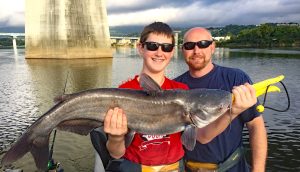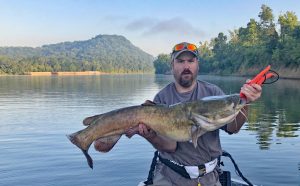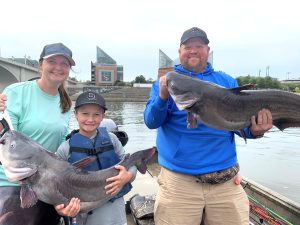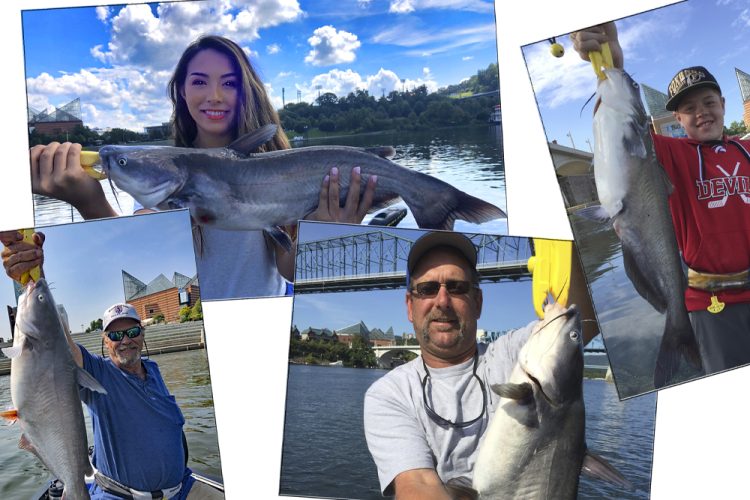These pictures all have one thing in common, and it’s not the catfish. Look in the background and you will see the well-known Tennessee Aquarium in downtown Chattanooga. There are days when the best catfishing can be found among the concrete jungle. (Photos by Capt. Richard Simms)
Head Downtown for Urban Catfishing
by Capt. Richard Simms
Instead of escaping it, catfishermen may want to go to the concrete jungle.
If you review the Photo Gallery on the Scenic City Fishing Charters website, you will likely come across photos with one very unique building in the background: the Tennessee Aquarium in downtown Chattanooga.
I often joke whenever I post a picture of clients with the Aquarium in the background. My standard line on social media is, “Hey, Aquarium folks. One of your catfish got out, but don’t worry. We caught him.”
Scenic City Fishing catfishing guides routinely cover up to 40 miles of the Tennessee River, mostly on Chickamauga and Nickajack lakes. However, at certain times of the year, they gravitate to the few miles in and around downtown Chattanooga.
“My customers like seeing the city from the water,” said Capt. Joe Jellison, better known on YouTube as Chatt Cats. “The bridge pilings on the numerous downtown bridges provide good structure for the catfish. And lots of barges are stored along the river near downtown. They also attract lots of catfish.”
Chattanooga has five major bridges that cross the Tennessee River. That means there are about 16 large bridge pilings, most with chunk rock and scour holes at their bases. If you fished each one for only 30 minutes, it would still take you eight hours to fish them all.

“Bridge pilings are my favorite for catfish,” said Capt. Sam Simons, who also runs “combo trips” for catfish and live baiting for smallmouth and largemouth bass. “We often catch a lot of great smallmouths off the bridge pilings.”
The other nice structure offered in downtown Chattanooga, and many other riverside cities, are barges. One Chattanooga company provides barge storage for companies to call on when they have river transport needs. But for much of the time, those dozens of barges are simply tied off, serving as fish attractors.
I’ve heard varying theories that explain what catfish like about the barges. Some say they actually take advantage of the large expanses of shade. Others suggest they’re attracted by the baitfish that also gather under the barges. Or in some cases, the large pilings the barges are tied to catch floating debris—logs and limbs that stay stuck beneath the surface. Whichever is the case, they are great places to fish.
We routinely spotlock our trolling motors upstream of the barges and cast baits underneath their bows. The company in Chattanooga frequently rotates or moves barges around. Capt. Aaron Massey points out that it is always best to key in on barges you know have been in the same spot for a long time.
“I like to target old moored boats that haven’t moved in a while—barges, marina docks or anything that makes shade on a bright sunny day,” said Capt. Massey.
The technique can pay great dividends as one of our clients learned. Lade Conlee lives in the Nashville, Tennessee area where the Cumberland River flows and also has numerous places where barges remain moored. After fishing with our guides, Conlee took the lessons he learned back to the Cumberland River.
“We find the secret to our success is catching flatheads from underneath the barges during the heat of the day, between 10 a.m. and 1 p.m.,” said Conlee.

“During the weekends, when I fish the most, there is very little competition. I never see anyone fishing around the barges,” he said. “My fishing partner, Mike Bombardieri, is with me about every weekend during the summer. We catch flatheads in the teens, twenties and thirties. My personal best flathead came on the morning of August 8, 2020. We saw one single barge by itself, and I thought, ‘Why not?’ We trolled over, got set up and it was not long before the rod tip doubled over. After a 15-minute fight, I landed a 34.5-pound flathead.”
Not to be bested, Bombardieri beat Conlee’s personal-best fish in May 2022.
“Mike hooked into a flathead that almost whipped him,” said Conlee. “It was just after noon and hot, but Mike persevered and landed his 43-inch flathead that weighed 39.8 pounds on my scale. But Mike swears it was over 40.”
Capt. Massey points out, “Don’t overlook the typical structure (in downtown settings). Just because the river is running through a city, it still has wood, rocks and bottom contours.”
Capt. Jellison said one his client’s personal-best blue came off that type of downtown structure.
“It was at night in September 2022,” said Capt. Jellison. “We actually did a free-line drift through the area a few hours before using the light tackle method. We broke off on a big fish.
“I told my client that we will anchor up there at dark and see if we can get redemption. Well, 10 minutes after setting up, the rod buries down, peeling drag. It was a new personal best for him, a 64-pound beast. I’ll never forget it.”

Capt. Massey says he will often offer clients a bit of a tour he calls “The Downtown Loop” along the Chattanooga riverfront.
“I think people love it,” he said. “The bridges, the Hunter Art Museum overlooking the river atop a huge bluff, the Tennessee Aquarium, the Southern Belle Riverboat and the Trail of Tears Memorial, all nestled in the shadow of historic Lookout Mountain. It all creates a spectacle that people enjoy, in addition to the fishing.”
Capt. Simons said his clients are thrilled to get a big fish with the Tennessee Aquarium in the background.
“Sometimes when we land a big fish, we might get to enjoy thunderous applause from people up on the (Walnut Street) walking bridge that crosses over the river, or from the Chattanooga Duck tour boats or paddle boarders.”
Of course, he says, there can be too much of a good thing.
“Sometimes the downtown section of the river gets very crowded with boat traffic and paddle boarders, depending on time of the year. But we usually squeeze right in there and make ourselves at home.”
Crowds are something you’ll never need to worry about on the mighty Mississippi River. That’s where Capt. Dan Pacassassi, owner of FishMemphis.com, calls home. The big water produces big fish.
“The biggest my clients have caught so far is 95 pounds. We’ve had dozens over 70,” said Capt. Pacassassi.
Fishing the Mississippi requires special knowledge of navigating and fishing big water with heavy current. Capt. Pacassassi fishes from a 26-foot SeaArk pushed by a 300-hp Suzuki.
He is very straightforward about where he fishes, saying, “I simply fish Memphis because it’s what I have.”
St. Louis, MO, under the Gateway Arch, is home for multiple catfish guides, as is Kansas City on the Missouri River. You can also check out catfish guides who use Richmond, Virginia as home base on the well-known James River.
Bottomline, catfish have no concerns about living in or near big cities. Even though skyscrapers may loom above, big blues or flatheads still swim below.
(Capt. Richard Simms is the Editor of our sister publication, CrappieNOW, as well as owner of Scenic City Fishing Charters. Formerly he was a game warden for the Tennessee Wildlife Resources Agency before becoming a photographer and PR guy for TWRA. That lead to a 30-year career as a broadcast journalist and freelance outdoor writer. Follow Capt. Simms on his Facebook page.)



